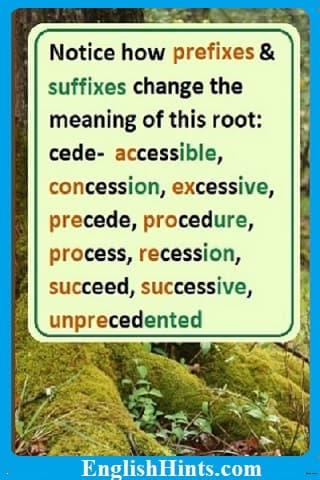How Roots, Prefixes, & Suffixes Build Words
Most English words are made up of smaller elements: roots, prefixes and suffixes. When you know the common ones and how to combine them, you can understand hundreds of different words.
The majority of academic vocabulary uses Latin roots and affixes. (Affixes are prefixes and suffixes.) They are especially useful for English university study or professional work.
Look at Word Parts to Learn New Words
If you already speak a Latin-based language like French, Spanish, Italian, or Portuguese, you have a huge advantage in reading academic English.
If not, you can still increase your vocabulary faster by studying roots and affixes.
As you study them you see will notice common patterns and recognize new words.
It’s easier to learn words in groups. Studying related words together helps you see the connections between them. That's why I include so much information on the words made from each root.
It's also useful to understand the ways suffixes can change the form (and part of speech) of English words. As you add suffixes to a word like 'act,' it fills different places in a sentence. (An actor acts in a play, but may also be active in a community group.) See Word Families and the Suffix section below for more information.
The sections below on roots, prefixes and suffixes link to pages with details or practice.
Roots
To study roots, see:
- Greek & Latin Root Words Table, a list or index of all the roots covered on these pages. It gives their meanings, examples, and the pages to practice each one.
- Root, Prefix, and Suffix Worksheets have inexpensive pdf worksheets to boost your vocabulary.
To practice words from a particular root, use the root words table above to find the right page or pages.
- 50 Latin Word Roots Practice (Gapfill),
- Classical Roots Crossword & Answers (right click to download), and

As you read new words, analyze them. Are parts familiar? Can you see a pattern?
For example, if you read about a retractable blade, you can guess its meaning before you look it up.
(Even better: guess instead of looking it up if its meaning isn't essential.
Don’t break your concentration unless you need the word to understand what you're reading. If not, write it down to check later.)
For retractable, you may know that the prefix ‘re’ means 'again' or 'back.' ‘Able’ means that something is possible. So you can guess 'retractable' is about the possibility of ‘tracting’ something back, or again.
‘Tract’ is also the base of ‘attract,’ ‘distract,’ and ‘traction,’ so it seems related to a pulling movement. Good guess! In fact, retractable wheels on an airplane can be pulled back into the body of the plane. Retractable hose is easy to rewind (pull back into storage.) Retractable awnings can be pulled back easily.
Here's another example of how prefixes and suffixes can change the meaning and use of a root. These words come from 'form':
conformity, formal, formality, format, formation, formula, formulate, inform, informally, informative, misinform, nonconformist, reformer, transformable, transformation, uninformed
Prefixes and Suffixes
Positive & Negative Prefixes
You can learn more prefixes like ‘re-‘ on the
alphabetical List of Prefixes (with examples) and Common
Greek and Latin Prefixes. (It's a table of the same prefixes arranged by English
meaning, so you can compare the Latin and Greek forms).
Practice prefixes of location and relationship (anti-, com-, ex-, in-, sub-, sym-, and trans- +) on 7+ Common Prefixes that Dominate Academic Vocabulary. The Prefix 'Re-' has its own page, with examples and practice.
The Negative Prefix List gives prefixes that make words negative. It has examples of each prefix and explains the differences in their meanings and use. Check your understanding on the Practice Negative Prefixes page.
Suffixes: Useful Word Endings
Suffixes sometimes change the meanings of words. More often they change their positions in a sentence. It’s very helpful to know the different endings that belong to different parts of speech. Adding an ending can change a word from one part of speech into another.
For example, adding ‘-ive’ to ‘act’ (a noun or verb) makes the adjective ‘active.’ If you add’ -ly’ to ‘active’ you get the adverb ‘actively.’ You could add ‘-ate’ instead to get the verb ‘activate.’
Each suffix means something different and fills a different place in a sentence.
If you recognize more suffixes, you'll understand more of what you read. You'll also be able to use the words correctly when you write.
- The List of Suffixes gives an alphabetical listing of the most common word endings.
- Suffix List Arranged by Use gives the same suffixes grouped by their purpose. (It lists suffixes to form nouns, verbs, adjectives or adverbs. It also discusses suffixes for plurals, different verb tenses, or comparatives.) It gives more examples and explains suffix use for the different parts of speech, tenses, etc.
- Practice Suffixes gives the meanings of some common word family members (agree, agreeable, agreement, etc.) Then it has multiple-choice questions. You decide which form would be best to use in different situations.
See also Word Families, Word Family Practice, and Word Formation Examples and Exercises.
Would you like a simpler, more organized way to learn the essentials for using roots and affixes?
The most efficient way to learn common roots and affixes is with a step-by-step course. This inexpensive course will teach you the most common prefixes, suffixes, and roots. You'll get the background you need to continue learning them as you keep reading in English.
Whether you take a course or study a few at a time, learning common roots, prefixes, and suffixes is worth the effort. Knowing how they combine can help you recognize hundreds of new English words!
Didn't find what you
needed? Explain what you want in the search box below.
(For example, cognates, past tense practice, or 'get along with.') Click to see the related pages on EnglishHints.
| site search by freefind | advanced |










New! Comments
What do you think about what you just read? Leave me a comment in the box below.